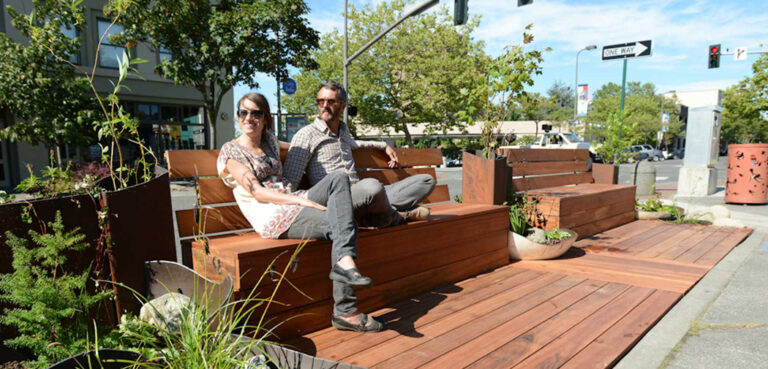From Parking to Park
Parklet Programs on the Rise

As people spend more time in cars, and take those cars to cities, many of those cities are choosing people over parking. Parklets, or miniature gathering spaces, are a relatively new but growing concept that adds public seating, beauty, and community to a city’s streets and sidewalks, all for the price of a couple parking spots.
San Francisco launched the inaugural parklet program – Pavement to Parks – in 2010. Since then, parklets have sprouted not only in San Francisco, but in Chicago, Portland, Seattle, New York City and Philadelphia, among other cities.
“Parklets create people-friendly streets,” says Dave Campbell, advocacy director of the nonprofit Bike East Bay. “They also provide a traffic-calming effect because of the narrowed look of the street.”
“Parklets are built out of semi-permanent materials and installed in a way that does not require reconfiguring the roadway or pouring concrete,” the San Francisco Great Streets Project describes. “They are usually hosted or sponsored by a local business or organization that pays to design and build them, and agrees to keep them maintained.” While parklets vary in design, they usually include seating and bike parking.
Parklets add aesthetic appeal because, well, planters are prettier than parking meters. In a neighborhood with narrow sidewalks, the parklet offers people a place to sit, relax and enjoy their surroundings. People can talk to their neighbors, enjoy their coffee or stop to let their kids have a snack.
Portland Street Seats
The Portland Bureau of Transportation launched a pilot parklet program, Street Seats, in 2012. The agency initiated an ongoing program a year later after positive community feedback.
Portland offers a range of Street Seats options, with priority given to public installations. Cafes and restaurants can also install private café seating for an extra $105 per linear foot right of way. “That option has opened up the number of interested businesses,” says Sarah Figliozzi, Bicycle Program Specialist for Portland’s Bureau of Transportation. “Portland has a very pedestrian scale. We have narrow sidewalks, so to have that extra seating during the summer months has been wonderful and well used.”
Portland also teams with Portland Center for Architecture to launch annual design competitions. The collaboration yields creative designs built with a mix of public and private funding.
Oakland Parklet Revival
Oakland, Calif., initiated a parklet program in 2011. Of the seven proposals accepted, three were built. The desire for a permanent program was there, but a staff shortage kept the program in limbo until 2014. The relaunched pilot program has generated 16 accepted parklet proposals in four of the city’s six districts.
“Most of these areas don’t have a lot of park space,” says Laura Kaminski, Parklet Program Manager for the City of Oakland. “Although this isn’t a park, it is a space where people can gather. From an economic development standpoint, it also brings attention to the sponsoring businesses. It’s a win for the city, the business and the community.”
While parklets may not work for every city, busy commercial neighborhoods could appreciate the extra space. Seventeenth Street near Broadway in downtown Oakland is an example of prime parklet territory.
“It has a narrow sidewalk, lower-scale buildings and trees, but there is no room for sidewalk dining,” Kaminski says. “Soon, you’ll be able to eat outside on a nice day.”
